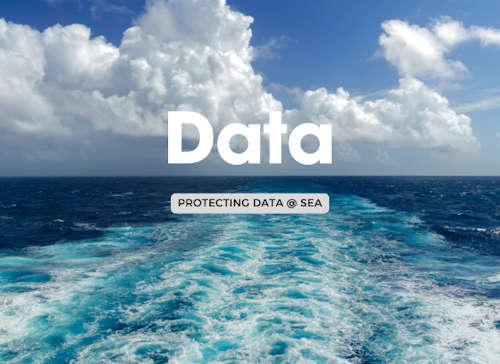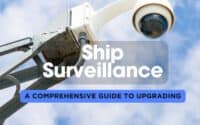8 Key Protocols for Commercial Vessels: Protecting Data in High Seas Operations
November 5, 2024

In an era where cyber threats are as prevalent as physical dangers on the high seas, commercial vessels face unique challenges in safeguarding sensitive data. As ships become more connected and rely on digital systems for navigation, communication, and operations, the need for strong cybersecurity measures is critical. Following these eight key protocols can help ship operators, owners, and crew ensure that their systems are resilient against cyber threats. Here’s an in-depth look at the top protocols every commercial vessel should prioritize.

1. IMO Maritime Cyber Risk Management Guidelines 🚢
- Description: The International Maritime Organization (IMO) developed these guidelines to provide a structured approach to managing cyber risks aboard ships. It integrates cybersecurity into the International Safety Management (ISM) Code, which is mandatory for all IMO-regulated vessels. The guidelines focus on assessing risks, implementing protections, detecting threats, and establishing response and recovery processes.
- Key Components:
- Risk Assessment: Conducting comprehensive assessments of potential vulnerabilities in onboard systems.
- Protection: Implementing firewalls, access controls, and system hardening techniques.
- Detection and Response: Continuous monitoring and incident response protocols for addressing cyber incidents in real-time.
- Importance: Ensures that vessels are compliant with international standards and prepared to handle cyber threats with well-defined processes.
- Risk Mitigation Level: High
- Website: www.imo.org
2. ISO/IEC 27001 (Information Security Management Systems) 🔒
- Description: ISO/IEC 27001 is an internationally recognized standard that provides a framework for information security management, applicable across industries and widely adopted in maritime cybersecurity. By implementing this standard, vessels can establish, maintain, and improve their information security systems, ensuring that data is protected, monitored, and managed systematically.
- Key Components:
- Information Security Policies: Clearly defined policies on data access, handling, and confidentiality.
- Access Control: Enforcing strict access measures, such as two-factor authentication and role-based permissions.
- Continuous Improvement: Regular audits and reviews to adapt to evolving cyber threats.
- Importance: A comprehensive approach to information security, reducing the risk of unauthorized access, data breaches, and other cyber threats.
- Certification Requirement: Recommended for fleet-wide implementation
- Website: www.iso.org
3. NIST Cybersecurity Framework 🛡️
- Description: The National Institute of Standards and Technology (NIST) Cybersecurity Framework provides a structured approach to managing cybersecurity risks. Although initially designed for critical infrastructure in the U.S., it has been widely adopted in the maritime sector. The framework’s five core functions—Identify, Protect, Detect, Respond, and Recover—guide ship operators in creating a resilient cybersecurity posture.
- Key Components:
- Identify: Conducting asset management and risk assessments to locate potential cybersecurity risks in systems and operations.
- Protect: Implementing safeguards like firewalls, access controls, and training to protect systems and data.
- Detect, Respond, Recover: Monitoring for potential threats, having a response plan for incidents, and outlining recovery strategies to restore operations.
- Importance: Offers a holistic approach, helping vessels systematically manage and reduce cybersecurity risks.
- Implementation Level: Flexible, adaptable to both large and small vessel operations
- Website: www.nist.gov
4. Maritime Cyber Baseline (by Lloyd’s Register) 📝
- Description: Lloyd’s Register developed the Maritime Cyber Baseline to establish a foundational cybersecurity standard specifically for maritime operations. This protocol provides a structured, checklist-based approach for assessing and maintaining cybersecurity on ships, ensuring minimum standards are consistently met.
- Key Components:
- Cybersecurity Assessment: A baseline assessment to gauge a vessel’s current cyber resilience, identifying critical vulnerabilities.
- Implementation of Cyber Hygiene: Enforcing basic protective measures like access control, software updates, and data backup.
- Regular Audits: Ongoing compliance checks to ensure the vessel maintains a minimum level of cybersecurity readiness.
- Importance: Helps ship operators establish a fundamental cybersecurity framework, addressing cyber hygiene with simple, actionable steps.
- Certification Level: Basic, aimed at ensuring minimum standards are met
- Website: www.lr.org
5. IEC 61162 (Maritime Navigation and Radiocommunication Equipment and Systems) 📡
- Description: The IEC 61162 standard is designed to ensure secure data exchange between maritime navigation and communication equipment. It covers interface protocols, including the integration of systems like Electronic Chart Display and Information System (ECDIS) and Automatic Identification System (AIS), which are essential for ship navigation and safety.
- Key Components:
- Data Security for Navigation Systems: Enforcing protocols that protect data integrity in critical navigation and communication systems.
- Standardized Interfaces: Ensures that data between systems is transferred securely and reliably, reducing the chance of data manipulation.
- System Compatibility: Ensures all navigation and communication systems work together seamlessly, minimizing vulnerability to cyber-attacks.
- Importance: Protects the vessel's essential navigation and communication systems, which are prime targets for cyber threats, enhancing operational safety and reliability.
- Compliance Requirement: Essential for vessels using integrated navigation and radiocommunication systems
- Website: www.iec.ch
6. IEC 62443 (Industrial Communication Networks – Network and System Security) 🔐
- Description: The IEC 62443 series provides comprehensive security guidelines for industrial control systems (ICS), making it highly applicable to maritime systems that control everything from engine monitoring to ballast and propulsion. It emphasizes securing control networks to protect against unauthorized access and operational disruptions.
- Key Components:
- Network Security Policies: Establishing strict access control measures and segmenting networks to reduce vulnerability to attacks.
- Secure Development Lifecycle: Requiring that software used in control systems is developed and maintained with security in mind.
- Incident Response Readiness: Developing protocols for detecting and responding to cyber incidents in control systems.
- Importance: Protects critical onboard control systems from cyber threats, ensuring continued safe operation of the vessel's industrial networks.
- Application Level: Advanced, ideal for vessels with complex industrial control systems
- Website: www.iec.ch
7. BIMCO’s Guidelines on Cyber Security Onboard Ships 🛳️
- Description: Developed by the Baltic and International Maritime Council (BIMCO), these guidelines provide practical cybersecurity recommendations for shipowners and operators. It offers guidance on protecting ship systems from cyber threats through best practices for access control, data protection, software maintenance, and crew training.
- Key Components:
- Access Control: Enforcing strict user permissions and authentication to ensure only authorized personnel can access critical systems.
- Data Integrity and Protection: Safeguarding data from tampering, with protocols for encryption and secure data transfer.
- Regular Software Updates: Ensuring all onboard systems are up-to-date to reduce vulnerabilities from outdated software.
- Importance: Offers actionable steps for operators to enhance cybersecurity practices, ensuring that vessels are resilient against a wide range of threats.
- Adoption Level: Industry-wide, suitable for fleets of all sizes
- Website: www.bimco.org
8. ISPS Code (International Ship and Port Facility Security Code) ⚓
- Description: While primarily focused on physical security, the ISPS Code also includes cybersecurity measures, especially for access control systems at ports and onboard ships. Compliance with ISPS requires that ships and port facilities implement security systems and procedures to protect against unauthorized access, which can also prevent cyber intrusions.
- Key Components:
- Access Security: Ensuring that only authorized personnel can access the ship’s critical areas, reducing risks from both physical and cyber threats.
- Threat Response Protocols: Outlining actions to be taken in the event of a security breach, including cyber incidents.
- Integrated Security Systems: Combining physical and cyber measures to protect against all types of intrusions, from on-board access points to communication networks.
- Importance: Provides a comprehensive approach to maritime security, addressing both physical and cyber threats to enhance overall resilience.
- Compliance Requirement: Mandatory for vessels engaged in international operations
- Website: www.imo.org
Table Summary
| ShipUniverse: Key Cybersecurity Protocols for Commercial Vessels | ||
|---|---|---|
| Protocol | Description | Key Takeaways |
| IMO Maritime Cyber Risk Management Guidelines | The IMO’s guidelines focus on integrating cyber risk management into a ship's daily safety operations. They outline a risk assessment process that helps vessels identify, detect, protect, respond to, and recover from cyber threats. Essential for compliance on all IMO-regulated ships. |
- Risk-focused: Emphasis on assessing and managing cyber risks - Compliance-oriented: Meets IMO standards - Actionable Steps: Set clear protocols for response and recovery |
| ISO/IEC 27001 | An international standard for information security, widely used across industries. Helps vessels maintain a systematic approach to protecting data, from access control to continuous monitoring. Great for fleets that want a structured, trusted framework. |
- Data Protection: Focus on data confidentiality and integrity - Access Control: Role-based permissions and authentication - Scalable: Suitable for single ships or large fleets |
| NIST Cybersecurity Framework | The NIST framework offers five core functions (Identify, Protect, Detect, Respond, Recover) to manage cybersecurity risks. Originally designed for critical infrastructure, it’s now used globally in the maritime sector for a well-rounded cybersecurity approach. |
- Holistic: Covers the entire cybersecurity lifecycle - Adaptive: Can scale for various vessel sizes - Proactive: Emphasis on risk identification and threat response |
| Maritime Cyber Baseline (by Lloyd’s Register) | This baseline assessment from Lloyd’s Register provides minimum standards for cybersecurity in maritime. It offers a structured checklist for cyber hygiene, ensuring basic compliance for all types of vessels. |
- Baseline Security: Ensures minimum cybersecurity standards - Checklist Approach: Simple steps for fleet-wide consistency - Accessible: Ideal for smaller operators |
| IEC 61162 | The IEC 61162 standard ensures secure data exchange between navigation and communication equipment. It standardizes interface protocols to keep data consistent and secure, essential for systems like ECDIS and AIS on board. |
- Data Security: Protects navigation data integrity - Standardized: Ensures system compatibility - Reliability: Reduces risk of data manipulation |
| IEC 62443 | The IEC 62443 series secures industrial control systems on ships, including engine monitoring and propulsion. It addresses access control, incident response, and secure software development, critical for shipboard systems. |
- Control System Security: Protects critical ship operations - Lifecycle Focused: Emphasis on secure software development - Incident Response: Prepares systems to detect and respond to threats |
| BIMCO’s Guidelines on Cyber Security Onboard Ships | Developed by BIMCO, these guidelines cover best practices for access control, software maintenance, and crew training. It emphasizes practical steps for strengthening vessel cybersecurity. |
- Access Control: Restricted access to critical systems - Data Integrity: Encryption and secure transfers - Up-to-Date: Regular software updates to prevent vulnerabilities |
| ISPS Code | Primarily for physical security, the ISPS Code also covers cybersecurity in areas like access control. Ensuring compliance with ISPS strengthens security for both physical and digital systems on board. |
- Access Security: Protects critical areas from unauthorized access - Integrated Approach: Combines physical and cybersecurity - Mandatory Compliance: Essential for international operations |

Do you have a Maritime Product or Service that may be of interest to Shipowners? Tell us about it here!
Do you have feedback or insights? Please reach out to editor @ shipuniverse.com



